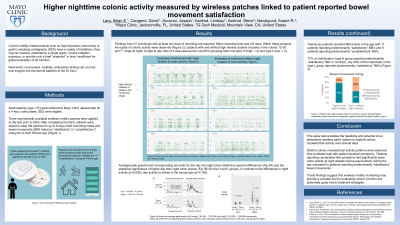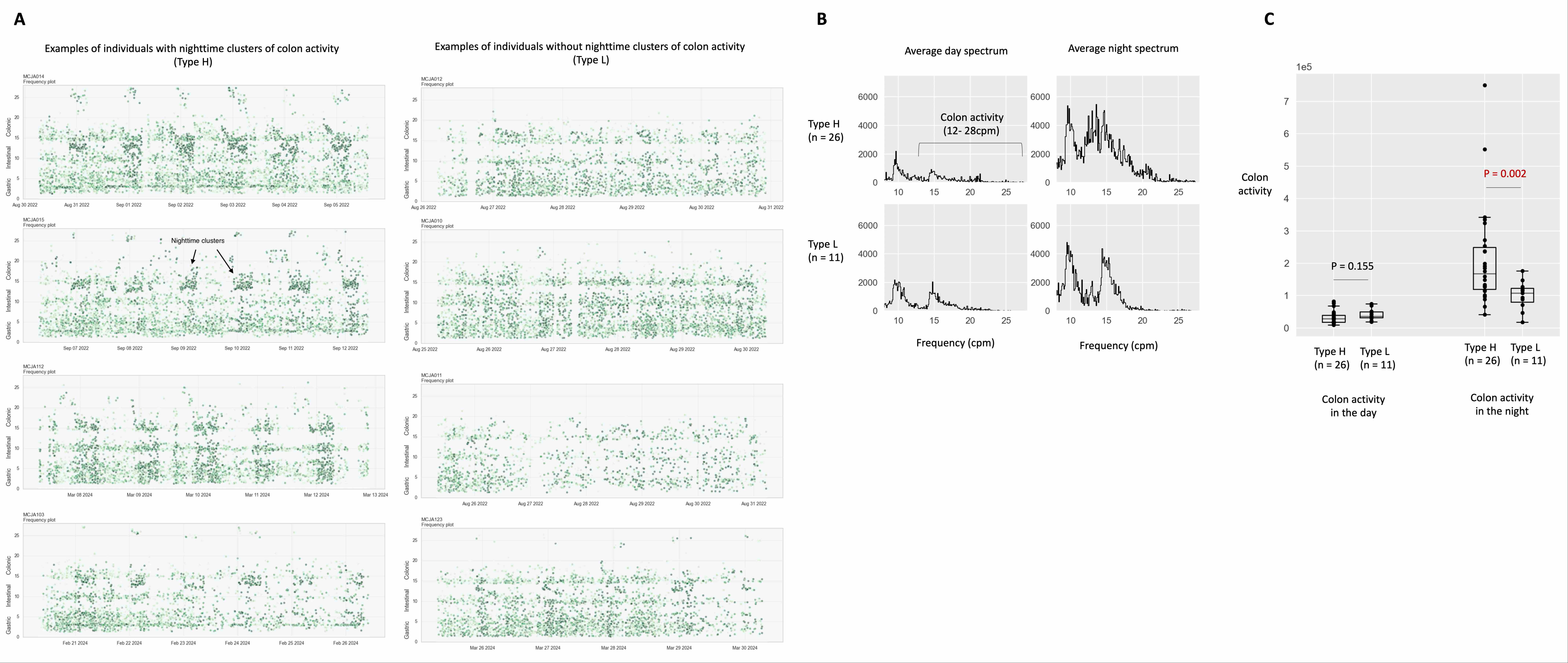Sunday Poster Session
Category: Colon
P0232 - Higher Nighttime Colonic Activity Measured by Wireless Patches Linked to Patient Reported Bowel Movement Satisfaction
Sunday, October 27, 2024
3:30 PM - 7:00 PM ET
Location: Exhibit Hall E

- BL
Brian E. Lacy, MD, PhD, FACG
Mayo Clinic
Jacksonville, FL
Presenting Author(s)
Award: ACG Outstanding Research Award in the Colon Category
Award: Presidential Poster Award
Brian E. Lacy, MD, PhD, FACG1, David J. Cangemi, MD1, Joseph Accurso, BS, MD1, Lindsay Axelrod, MS2, Steve Axelrod, PhD2, Anand Navalgund, PhD2
1Mayo Clinic, Jacksonville, FL; 2G-Tech Medical, Mountain View, CA
Introduction: Current motility measurements such as high-resolution manometry or gastric emptying scintigraphy (GES) have a variety of limitations: may be invasive, restricted to a single organ, involve radiation exposure, or provide only a brief “snapshot” in time, insufficient for global evaluation of GI function. Real-world, noninvasive multiday testing can uncover new insights within the diurnal patterns of the entire GI tract.
Methods: Adult patients referred to the nuclear medicine department at Mayo Clinic Jacksonville for a 4-hour, solid phase GES were eligible for study inclusion. Three wireless motility patches were applied to the skin prior to GES. Patients wore the patches for 6 days while recording meals and bowel movements (BM) (rated as “satisfactory” or “unsatisfactory”) using an iPhone app.
Results: Findings from 37 individuals with at least two days of recording are reported here. Mean recording time was 4.9 days. Within these subjects, two types of colonic activity were observed (Fig1A); subjects with and without visible nighttime clusters in the colonic12-28cpm range. A night to day ratio of 2 served as cut-off for grouping into type H (high; > 2) and type L (low; < 2). Average peak spectrums (Fig1B) and corresponding boxplots (Fig1C) for the day (7:00 AM–11:00 PM) and night (11:00 PM– 7:00 AM) show lower day time activity for both groups compared to the nighttime with slightly elevated day time colonic activity for type L compared to type H. Nighttime activity was significantly higher for the type H group compared to type L. Twenty-six patients had recorded BM events in the app with 17 patients reporting predominantly “satisfactory” BM’s and 9 patients reporting predominantly “unsatisfactory” BM’s. 77% of the individuals in the type H group reported predominantly “satisfactory” BM, while 23% reported predominantly “unsatisfactory” BM. In contrast, 55% of the individuals in the type L group reported predominantly “unsatisfactory” BM, while 45% reported predominantly “satisfactory” BM.
Discussion: This study demonstrates the feasibility of a wireless motility patch system to capture colonic myoelectrical activity over several days. Distinct colonic myoelectrical activity patterns were observed, with higher nighttime activity correlating with more frequent reports of “satisfactory” bowel movements. These findings suggest that wireless motility monitoring may provide a valuable tool for evaluating colonic function and potentially guide future treatment strategies.

Disclosures:
Brian E. Lacy, MD, PhD, FACG1, David J. Cangemi, MD1, Joseph Accurso, BS, MD1, Lindsay Axelrod, MS2, Steve Axelrod, PhD2, Anand Navalgund, PhD2. P0232 - Higher Nighttime Colonic Activity Measured by Wireless Patches Linked to Patient Reported Bowel Movement Satisfaction, ACG 2024 Annual Scientific Meeting Abstracts. Philadelphia, PA: American College of Gastroenterology.
Award: Presidential Poster Award
Brian E. Lacy, MD, PhD, FACG1, David J. Cangemi, MD1, Joseph Accurso, BS, MD1, Lindsay Axelrod, MS2, Steve Axelrod, PhD2, Anand Navalgund, PhD2
1Mayo Clinic, Jacksonville, FL; 2G-Tech Medical, Mountain View, CA
Introduction: Current motility measurements such as high-resolution manometry or gastric emptying scintigraphy (GES) have a variety of limitations: may be invasive, restricted to a single organ, involve radiation exposure, or provide only a brief “snapshot” in time, insufficient for global evaluation of GI function. Real-world, noninvasive multiday testing can uncover new insights within the diurnal patterns of the entire GI tract.
Methods: Adult patients referred to the nuclear medicine department at Mayo Clinic Jacksonville for a 4-hour, solid phase GES were eligible for study inclusion. Three wireless motility patches were applied to the skin prior to GES. Patients wore the patches for 6 days while recording meals and bowel movements (BM) (rated as “satisfactory” or “unsatisfactory”) using an iPhone app.
Results: Findings from 37 individuals with at least two days of recording are reported here. Mean recording time was 4.9 days. Within these subjects, two types of colonic activity were observed (Fig1A); subjects with and without visible nighttime clusters in the colonic12-28cpm range. A night to day ratio of 2 served as cut-off for grouping into type H (high; > 2) and type L (low; < 2). Average peak spectrums (Fig1B) and corresponding boxplots (Fig1C) for the day (7:00 AM–11:00 PM) and night (11:00 PM– 7:00 AM) show lower day time activity for both groups compared to the nighttime with slightly elevated day time colonic activity for type L compared to type H. Nighttime activity was significantly higher for the type H group compared to type L. Twenty-six patients had recorded BM events in the app with 17 patients reporting predominantly “satisfactory” BM’s and 9 patients reporting predominantly “unsatisfactory” BM’s. 77% of the individuals in the type H group reported predominantly “satisfactory” BM, while 23% reported predominantly “unsatisfactory” BM. In contrast, 55% of the individuals in the type L group reported predominantly “unsatisfactory” BM, while 45% reported predominantly “satisfactory” BM.
Discussion: This study demonstrates the feasibility of a wireless motility patch system to capture colonic myoelectrical activity over several days. Distinct colonic myoelectrical activity patterns were observed, with higher nighttime activity correlating with more frequent reports of “satisfactory” bowel movements. These findings suggest that wireless motility monitoring may provide a valuable tool for evaluating colonic function and potentially guide future treatment strategies.

Figure: Figure 1A. Shows the two types of colonic activity observed ; subjects with (Type H) and without (Type L) visible clusters in the colonic 12-28cpm range at night. Fig1B shows the average peak spectrums for the day (7:00 AM – 11:00 PM) and night (11:00 PM – 7:00 AM) time periods. Fig 1C shows the corresponding total colonic activity for each individual subject between type H and type L during daytime and nighttime.
Disclosures:
Brian Lacy: AbbVie – Consultant. Ardelyx – Consultant. Gemelli Biotech – Consultant. Ironwood Pharmaceuticals – Consultant. Salix Pharmaceuticals – Consultant. Takeda – Consultant.
David Cangemi indicated no relevant financial relationships.
Joseph Accurso indicated no relevant financial relationships.
Lindsay Axelrod: G-Tech Medical – Employee.
Steve Axelrod: G-Tech Medical – Employee.
Anand Navalgund: G-Tech Medical – Employee.
Brian E. Lacy, MD, PhD, FACG1, David J. Cangemi, MD1, Joseph Accurso, BS, MD1, Lindsay Axelrod, MS2, Steve Axelrod, PhD2, Anand Navalgund, PhD2. P0232 - Higher Nighttime Colonic Activity Measured by Wireless Patches Linked to Patient Reported Bowel Movement Satisfaction, ACG 2024 Annual Scientific Meeting Abstracts. Philadelphia, PA: American College of Gastroenterology.

